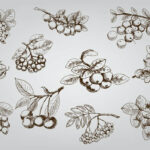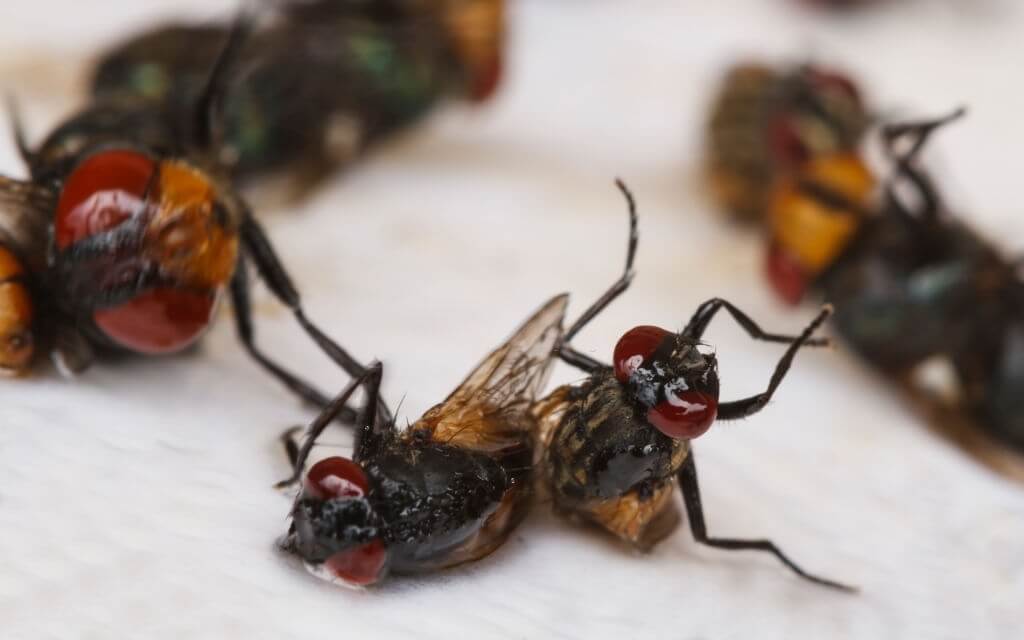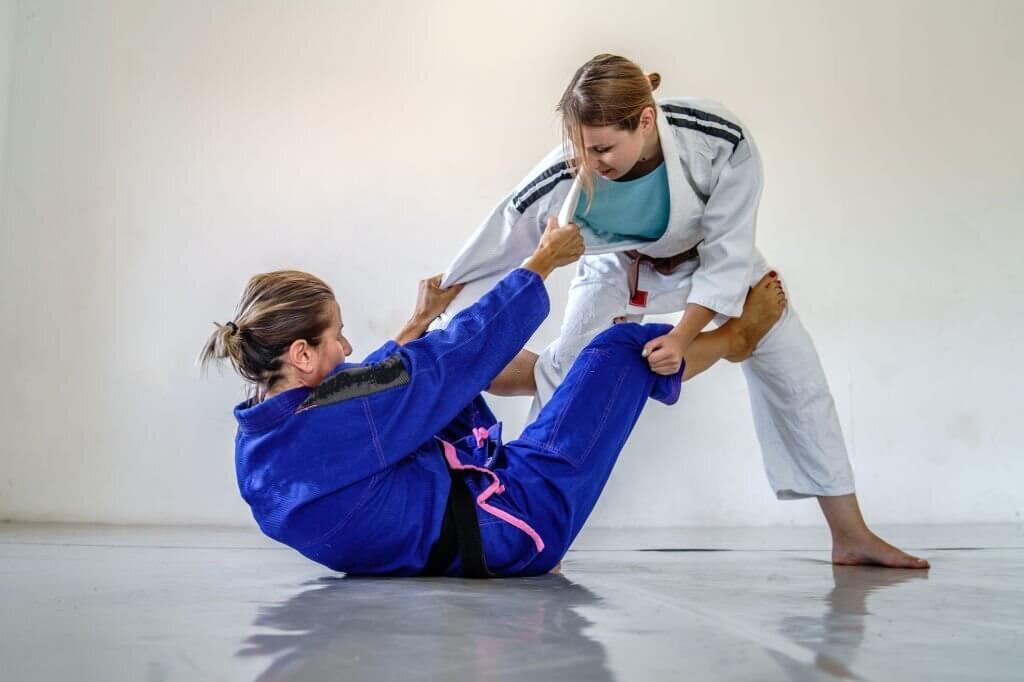Most homes and businesses eventually experience problems with indoor flies. Though relatively few kinds of flies can breed and complete their life cycles inside a structure, each indoor fly species is unique. For that reason, it’s important to correctly identify the type of fly in your home in order to control it.
Flies are one of the largest groups of insects. Unlike most other winged insects, which have four wings, flies have only two. This difference distinguishes them from nearly all other insect orders.
Control suggestions
Sanitation The key any indoor fly problem is to find and eliminate the source, that is, anywhere excess moisture and organic debris may have accumulated. Moisture is critical for fly breeding. Fly larvae cannot breed without some source of water, so look for areas with moisture. Sanitation suggestions include:
• Find and clean up any spilt or spoiled food on floors or in pantries
• Clean sink and bathtub/shower drains 6
• Check under liners in garbage containers and, if necessary, use soap and water to remove all organic residues
• Clean under and around the floor drain covers—especially in commercial buildings
• Clean under foam floor mats in commercial kitchens
• Hang mops off the floor to encourage drying— do not store dirty mops
• Inspect and clean under and around the feet of refrigerators or other kitchen equipment where organic matter collects
• Check and clean condensate lines and trays associated with refrigerators and ice makers
• Look for cracked or loose ceramic floor or bath tiles that could hide bacterial films
• Check for signs of rodents or other wildlife that might indicate the presence of a dead animal— seal any potential animal entry points
Drain and septic treatment
To check whether a drain is the breeding site, place a length of clear packing tape across the drain without totally covering the opening. If you cover the opening completely, there will be no airflow and flies may not emerge. Check the tape periodically. If you see flies stuck to the tape, you have found a source of the infestation.
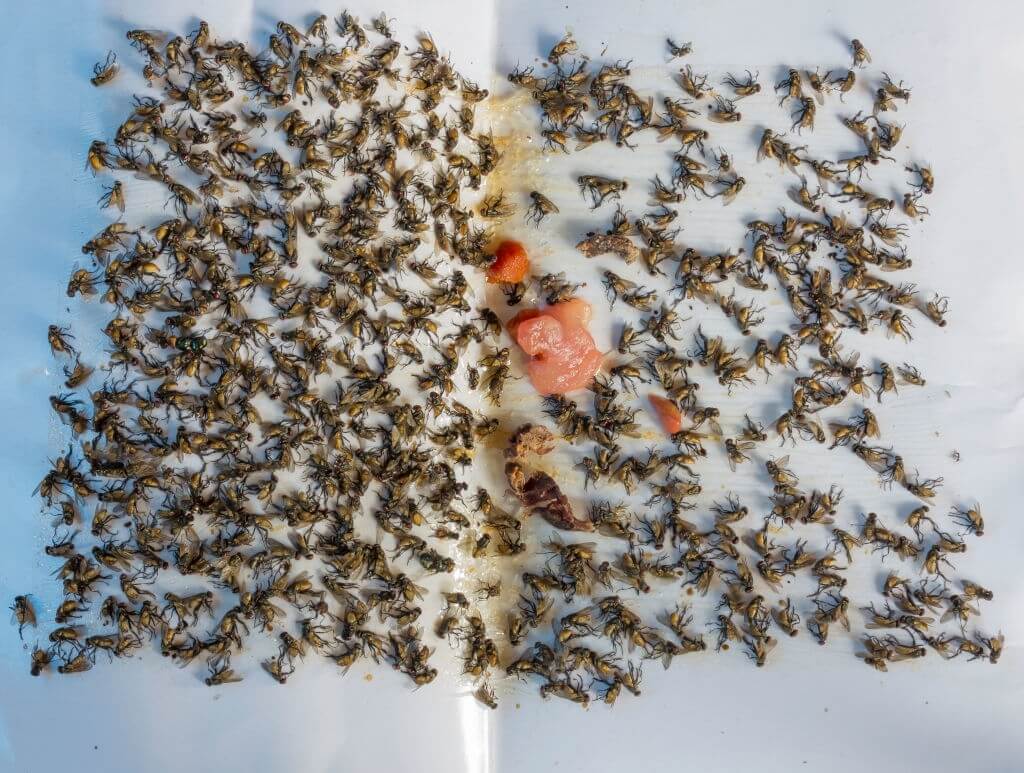
After locating the sources, drains must be cleaned to eliminate any bacterial film inside the plumbing. Chlorine bleach or drain cleaner is largely ineffective at removing such films. To eliminate these breeding sites, you must clean the pipes and traps with a stiff brush. After scrubbing, flush the lines with hot to boiling water to remove any material left in them.
An alternative to scrubbing is to use an antibacterial drain product designed to biodegrade organic films. These drain treatments usually require repeat applications over several weeks to eliminate the bacterial films. If you have a septic system, make sure any drain cleaning product you use is compatible with your system.
Most insecticides are not labelled for use in drains; however, S-hydroprene (Gentrol) can be used in drains as a spray or foam. It may also be applied to other areas that are not easily cleaned. Hydroprene is a low-toxicity insect growth regulator that disrupts the fly’s life cycle. This product does not kill adult flies, but it does prevent larvae from completing their development.
Traps
Light traps take advantage of a fly’s attraction to short-wavelength light (ultraviolet, or UV) to draw them to a glue board or low voltage electric grid. They are most effective for larger flies, like house flies, but may also trap small flies and other flying insects. Light traps should be installed 4 to 6 feet above the floor, which is the typical flying height for house flies. Because lights can attract flies from a distance, they should be mounted so they are not visible from the outdoors. Most light trap manufacturers recommend that the bulbs be replaced annually because the UV output of fluorescent tubes degrades over time. High voltage, outdoor “bug zappers” should not be used indoors because they tend to scatter insect fragments and can contaminate the indoors.
Also, Read @ Easy Ways to Get Rid of Neck Fat Fast
Baited traps are frequently used for fruit flies and, occasionally, for other flying insects. Though bait traps alone rarely provide adequate fly control, they can help pinpoint the source of a fly problem, monitor the success of control program, or help reduce fly numbers as you find and eliminate breeding sites. Traps can be as simple as a plastic bowl containing an attractant, apple cider vinegar, and a few drops of soap to drown flies that attempt to land on the solution. They can also be commercial traps with funnels or small entry ports that make escape difficult. In natural settings, fruit flies are attracted to fermenting fruits. Suitable attractants for traps include apple cider vinegar, wine, bananas, orange slices, apple cider, etc. You can add a small amount of yeast to the trap material to increase its attractiveness; however, the odor of fermenting baits may be objectionable indoors. These types of baits may need to be replaced every few days. Some commercial traps use low odor lures that can last as long as a week. Such traps can capture large numbers of fruit flies.
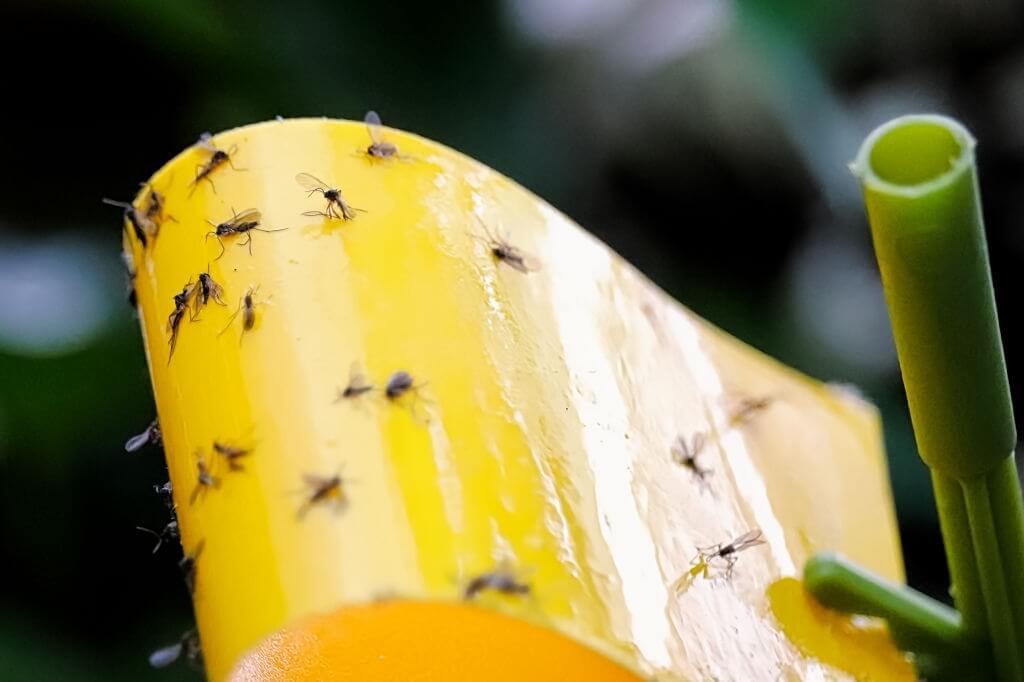
In natural settings, fruit flies are attracted to fermenting fruits. Suitable attractants for traps include apple cider vinegar, wine, bananas, orange slices, apple cider, etc. You can add a small amount of yeast to the trap material to increase its attractiveness; however, the odor of fermenting baits may be objectionable indoors. These types of baits may need to be replaced every few days. Some commercial traps use low odor lures that can last as long as a week. Such traps can capture large numbers of fruit flies.
Insecticides for fly control
Once the fly-breeding areas are cleaned or eliminated, you should not need to use insecticides. However, insecticides are sometimes helpful to knock down remaining adult flies, or to help control flies that come in from other locations.
Pyrethrin aerosol sprays, or other “flying insect” sprays, can provide temporary control of adult flies indoors. For outdoor fly problems, a residual insecticide labeled for outdoor fly control can be applied to fly resting sites. When mosquitoes or house flies are common outdoors, spray door entryways with one of these insecticides to reduce the number of flies that enter the house with human traffic. Be sure to follow label directions carefully, as many insecticide labels now prohibit spraying pavement, surfaces exposed to rain, or surfaces that drain onto the pavement. The goal of these precautions is to prevent insecticides from being washed into streams or storm drains.
In some cases, commercial baits are available for controlling house flies. Bait formulations include products that can be used in bait stations or applied as a liquid or slurry to areas where flies land. Some baits can be toxic to pets or livestock, so follow label safety precautions.
Also, Read @ How To Hypnotize Someone A Beginners Guide

